Miscanthus sinensis
Have you been gazing at your garden, wondering what it might be missing? Are you craving a whisper of the wild?
Allow me to introduce an ornamental superstar, Miscanthus sinensis, otherwise known as Japanese or Chinese silver grass, and affectionately called maiden grass.
A true garden sensation, maiden grass has an incredible knack for transforming mundane garden beds into stunning landscapes that rival an Impressionist painting.
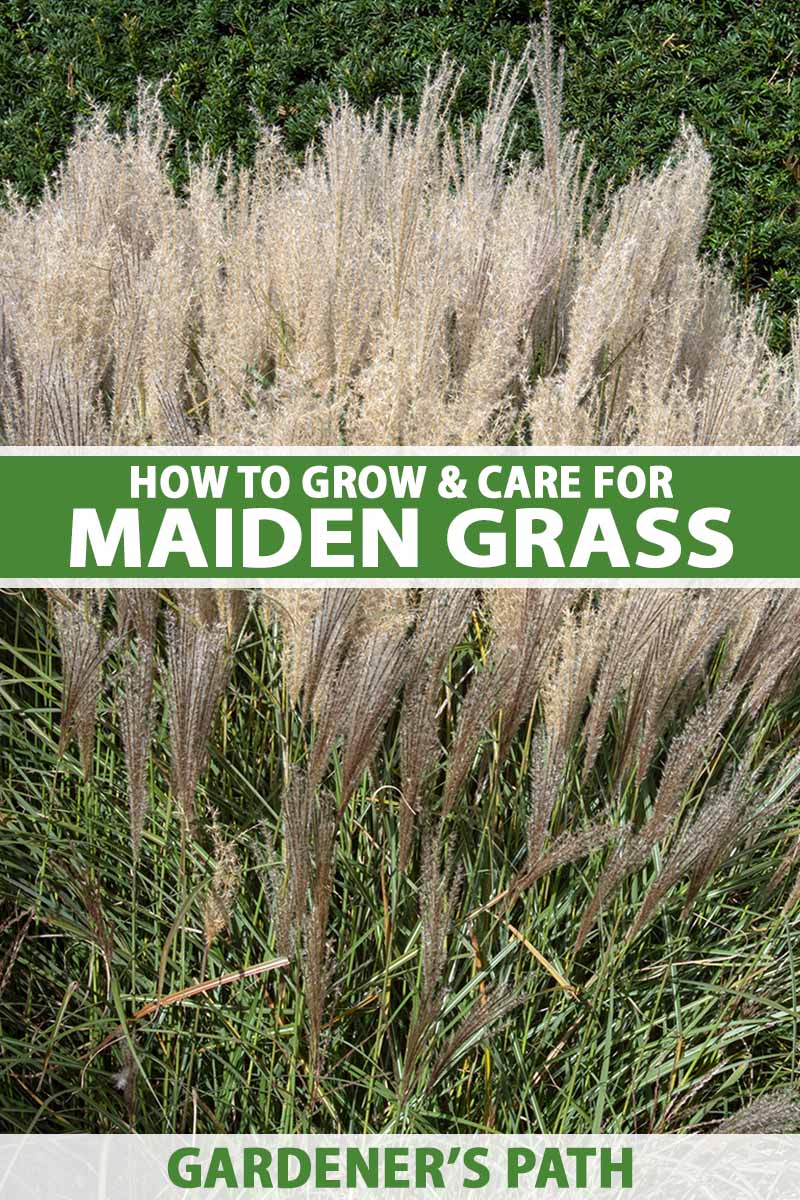
We link to vendors to help you find relevant products. If you buy from one of our links, we may earn a commission.
A sensory feast, it brings gentle movement, soothing sound, and aesthetic charm, breathing life into your design.
Hardy and versatile, adding height, depth, and texture, this all-season perennial could be the missing piece in your gardening plan.
Get ready for a whimsical adventure as we explore the wild and wonderful world of maiden grass.
Here’s a look at what I’ll be covering in this guide:
What You’ll Learn
What Is Maiden Grass?
M. sinensis, commonly referred to as maiden grass, Japanese silver grass, or Chinese silver grass, is an ornamental perennial native to Eastern Asia.
It belongs to the Poaceae family and the genus Miscanthus, though it was formerly classified as a species of Eulalia.

This species is also referred to in common parlance as eulalia grass, and it is called susuki in Japan.
Maiden grass is recognized for its upward-arching stems and leaves, which create a rounded, fountain-like appearance. It has a clump-forming habit, reaching heights of four to 12 feet, and spreading three to six feet wide.
Its colorful foliage and showy, textured flower plumes make it an attractive choice for ornamental gardening.
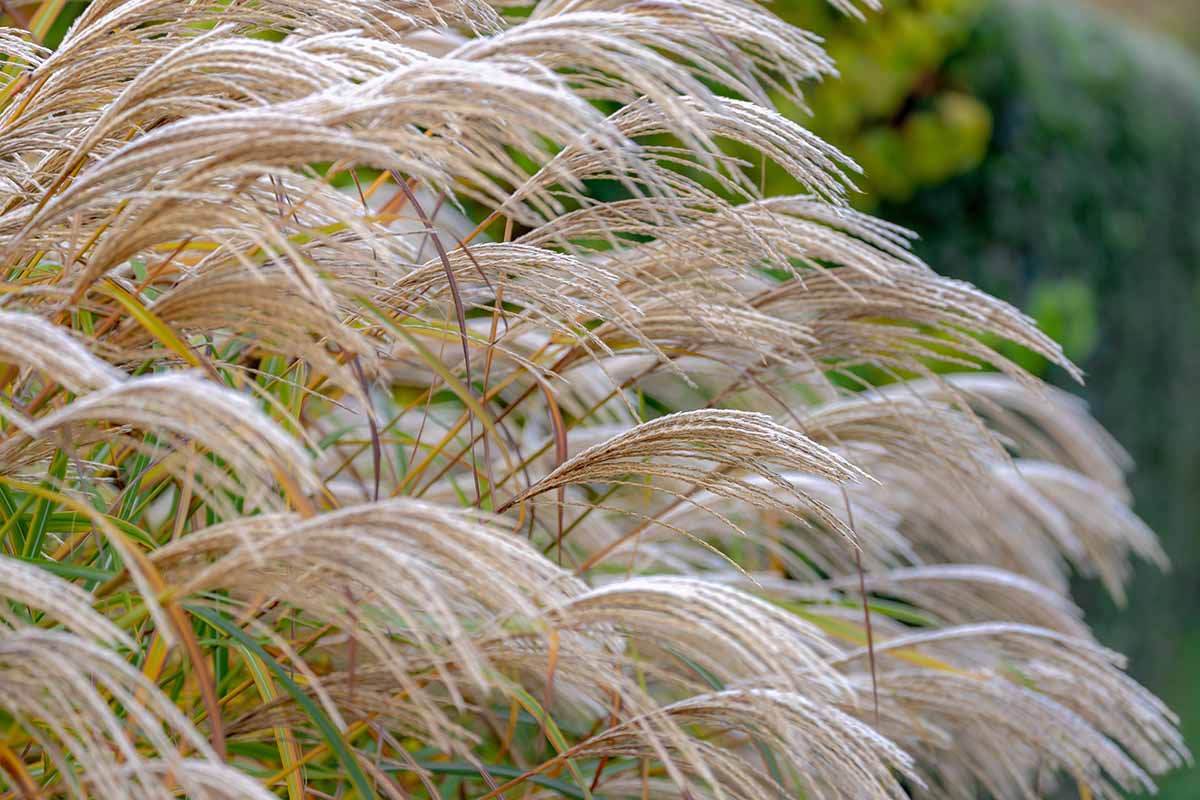
Differentiating M. sinensis from other ornamental grasses requires a close and careful look at its characteristic features: blade-like leaves with serrated margins and whitish to silvery midribs, and pink to red flowers that grow in loose terminal panicles.
It grows best in USDA Hardiness Zones 4 to 9, but has invasive potential in certain North American regions.
In the cooler months, maiden grass provides seasonal interest as its foliage turns yellow to orange, typically in the fall, then fades to a beige-tan color in the winter.
Depending on the variety, from late August to October, pink to red plumes of small flowers bloom above the foliage.
The seeds mature by mid-fall and the plumes turn beige, retaining their arching shape and beige color throughout the winter.
Cultivation and History
The Latin word sinensis, meaning “from China,” reveals this plant’s geographic origin.
It was described by Eduard Hackel, an Austrian botanist specializing in agrostology, or the study of grasses, in the late 19th century.

M. sinensis has a long history of cultivation in its native regions of Japan, Korea, and China, specifically an area that extends north to the subarctic Kuril Islands of Russia and the Hokkaido islands of Japan, south and west through the main islands of Japan, the Korean Peninsula, and eastern China, and into the subtropics of Ryukyu, Japan, and Taiwan.
In its native range, Chinese silver grass has long been used for roof thatching on traditional buildings, and although it’s not as popular as it once was, this material is still being used in roofing today.
It’s also used to make yellow dye, and storage bags for charcoal. And in Japan, maiden grass is used to stabilize easily erodible soils and is sometimes planted to revegetate abandoned ski slopes.
Because Japanese silver grass is highly productive and uses nutrients and water efficiently, it has been identified as a potential biomass energy crop capable of producing electricity.
Of particular interest is the sterile triploid Chinese silver grass hybrid Miscanthus × giganteus. In Korea and western Japan, it’s been used as organic fertilizer.
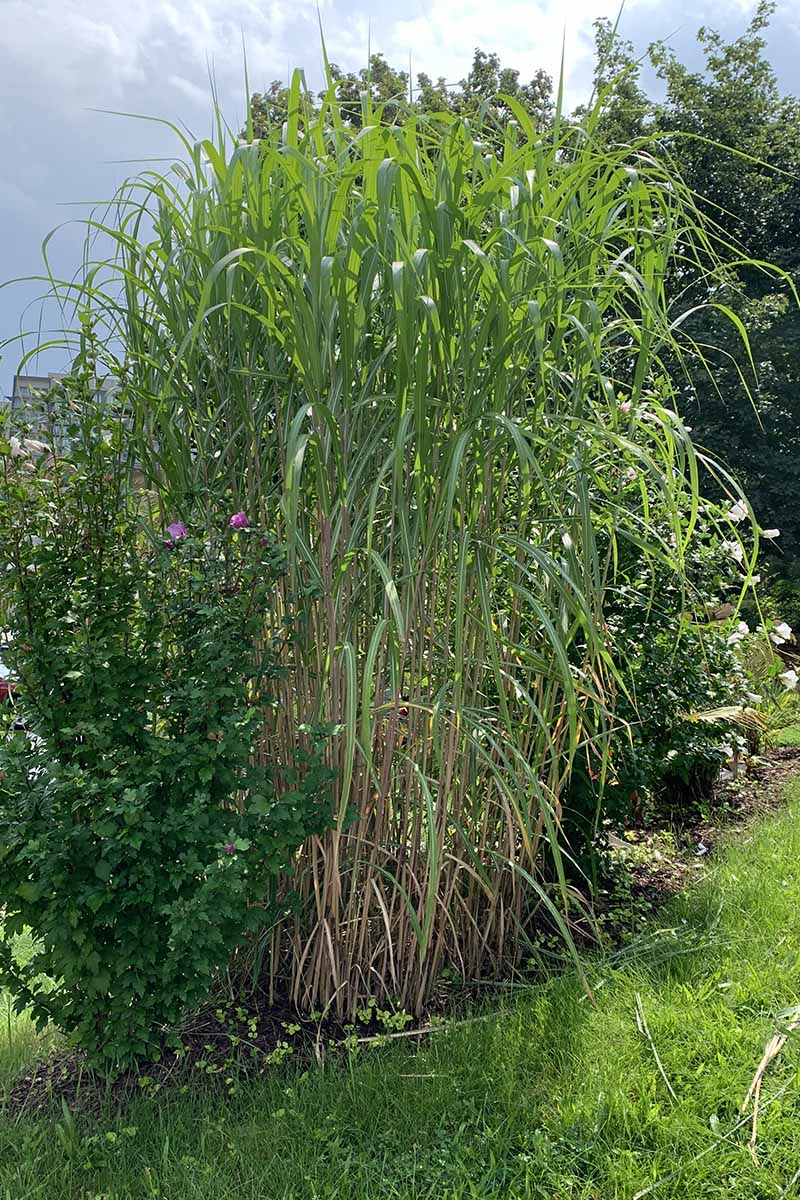
The exact timeline and route of maiden grass’s introduction to North America is unknown. However, we do know that by the early 1940s, it was present in the eastern United States.
Early observations of “wild types” were documented along roadsides and railroad tracks in New Jersey, Pennsylvania, and West Virginia. In 1942, it was described as “abundantly naturalized” in Washington, DC. But how did this happen?
M. sinensis was initially cultivated in the United States for its aesthetic appeal, providing texture, color, and movement in landscape designs, with numerous versatile applications, including naturalized and wild gardens, borders, meadows.
Over time, maiden grass gained popularity due to its adaptability to a wide range of soils and conditions, its low-maintenance nature, and its multiple uses – from creating privacy screens to dried flower arrangements.
Over the years, maiden grass breached cultivation in North America, and it was spotted growing wild in many eastern states, from Massachusetts southwards across the Mid-Atlantic and southeastern states.
It’s also been reported in Great Lakes states including Ohio, Michigan, and Illinois, as well as in Ontario, Canada, and in western regions of the US as well, including parts of Colorado and California.
It’s now considered an invasive species in certain states, including North Carolina. Do your research in these areas, and look for alternatives or cultivars specifically bred to be sterile.
Species plants and some cultivars are capable of reproducing from seed, allowing them to easily escape cultivation. But other commercially available cultivars are sterile and can only be propagated in other ways. Let’s investigate further.
Maiden Grass Propagation
Home gardeners can propagate some cultivars of M. sinensis from seed, while other cultivars can only be reproduced clonally.
You can divide mature plants in your garden, or purchase seedlings or clones from nurseries and greenhouses.
What does this mean? We have options! Well, depending on the desired cultivar, that is. Let’s take a look at these methods.
From Seed
Before we jump right into learning to grow maiden grass from seed, we should probably clear some things up.
Propagation of M. sinensis from seed is uncommon with the ornamental cultivars you’ll find in your local nursery.

That “wild type” I mentioned earlier, the species plant, is the one that usually produces a significant number of seeds that become airborne, and dispersal is enhanced in open, blustery swaths of land, like along interstate highways.
Cultivars such as ‘Variegatus,’ ‘Cosmopolitan,’ and ‘Zebrinus’ are good choices as there is no record of them self-seeding and becoming invasive.
Additionally, Miscanthus is self-incompatible, meaning one individual plant, grown in isolation, cannot usually develop seed.
Being aware of the potential for unintentional spread of some cultivars as well as the species plant is important. Here are a few words of wisdom for responsible maiden grass parents:
Refraining from planting the “wild type” of M. sinensis is crucial for home gardeners to avoid contributing to its invasive spread.
Existing ornamental plantings should be monitored carefully for self-seeding into nearby gardens, woodlands, or natural areas, especially in regions where M. sinensis has become invasive.
Now that you’re educated on potential risks to avoid, let’s walk through the process of growing maiden grass from seed.
Plan to start your seeds indoors in late winter or early spring. You can direct sow outdoors, but for more control over conditions, it’s best to perform this task indoors or in a greenhouse.
Fill a seed tray or small pots with a seed-starting mix. We recommend Tank’s Pro-Lite Seeding and Potting Mix, available at Arbico Organics.
Pro-Lite Seeding and Potting Mix
Next, place the seeds on the surface of the soil. Don’t cover the seeds with soil, but gently press them into it. These seeds need light in order to germinate.
Water the seeds gently so the soil is moist but not waterlogged. I like to use a spray bottle and mist them with water for this step.
Place the seed tray in a location where it will receive bright but indirect light with temperatures between 62 and 72°F (16 to 22°C). Maintain a consistent level of moisture during the germination period. Germination can take seven to 28 days.
When the seedlings are large enough to handle, you can transplant them into larger pots or containers, or move them directly to your garden, depending on your current local conditions. I’ll discuss the transplanting method a little later. Read on!
Division
M. sinensis can be propagated by dividing mature plants. This involves splitting an established clump into smaller sections, each with its own roots.
It’s important to note that some cultivars are protected by patents, making propagation illegal.
Before you attempt this method of propagation, check your plant tag or do the necessary research on whichever variety you have planted.
The best time to perform this process is in the spring. Start by watering your plant thoroughly a day before dividing it to minimize stress.
Dig around the clump, going deep enough with your shovel to get under the root ball. Lift the loosened clump out of the ground.
Using a sharp, clean spade or gardening knife, cut the clump into sections. The number of sections will depend on the size of your original clump but each should have a good amount of roots and shoots for successful replanting.
Plan to replant your divisions straight away, or as soon as possible after performing surgery. Now that we’re at the point of replanting, let’s learn how to transplant.
Transplanting
Here’s a step-by-step method to put your divisions, potted nursery plants, or new seedlings into the ground:
Start by preparing your planting site. Maiden grass is a sun worshiper, so aim for a full sun location, or somewhere it can receive at least six hours of sunlight each day.
It also prefers well-draining soil, so avoid areas of standing water or where water might pool after a rainstorm.
If your soil is heavy clay, you might want to amend it with organic matter like compost or aged manure to improve the structure and drainage.
At maturity, these plants can spread up to five feet, so plan for enough space when choosing your location. Clear away weeds and debris to create a clean space for your new plant to set its roots.
To prepare your Japanese silver grass for transplant, ensure that it has been watered well prior to planting day.
Try not to disturb the roots too much when removing transplants from their pots. If they’re pot bound, tease the roots apart and trim off any dead or unhealthy roots.
Dig a hole at least twice as wide as the root ball and just as deep. Place the plant in the hole, ensuring the top of the root ball is level with or just slightly below the surface of the soil.
Backfill the hole with soil, pressing gently around the plant and tamping the soil down gently to eliminate air pockets. Water your new planting well, giving it a big drink.
How to Grow Maiden Grass
M. sinensis is quite cold-hardy and can be grown in USDA Hardiness Zones 4 to 9. This means it can tolerate winter temperatures down to -30°F (-34°C).
Maiden grass prefers a full sun location, so choose a spot where your plant will get at least six hours of sunlight each day. In hotter climates, it may appreciate a little afternoon shade.
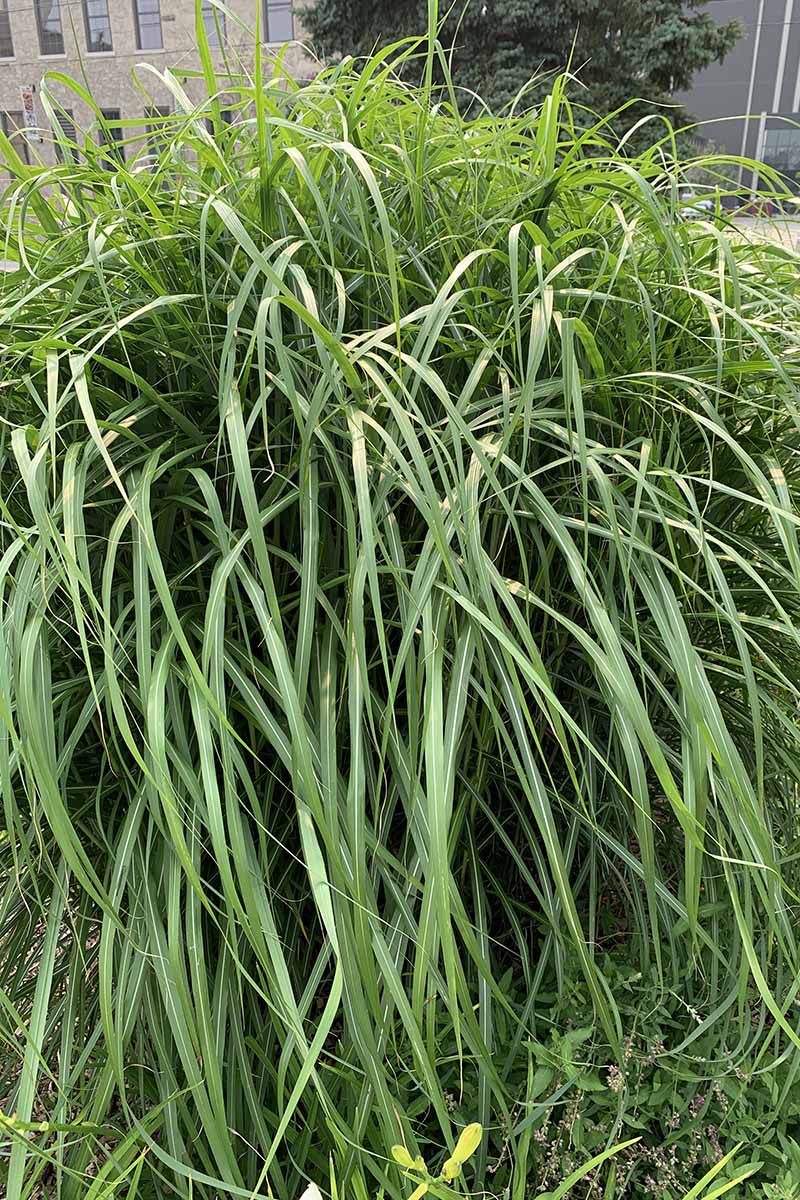
M. sinensis grows best in well-draining soil. It’s tolerant of a variety of soil types, including sandy, loamy, and clay soils, as long as water does not pool.
If your soil is heavy clay and does not drain well, consider amending it with organic matter, such as compost or well-rotted manure, to improve drainage and fertility.
Maiden grass is tolerant of a range of soil pH levels. However, it generally prefers a slightly acidic to neutral pH between 5.5 and 7.0.
This range allows for optimal nutrient absorption by the plant. If the pH is too high or too low, it can limit the plant’s ability to take in certain nutrients, even if they are present in the soil.
If you’re unsure of your soil’s pH, you can have it tested through a local extension service or with a home testing kit.

Garden Tutor sells a simple test kit on Amazon that will do the job. Read more about recommended soil test kits in our guide.
If necessary, the pH may be adjusted with lime (to raise pH) or sulfur (to lower pH), following package directions for application rates.
Although M. sinensis doesn’t have a particularly high demand for nutrients, a balanced fertilizer can be applied in the spring as new growth appears to encourage vigorous growth.
This can be a granular or liquid fertilizer with a balanced N-P-K ratio, like 10-10-10. Follow the manufacturer’s instructions for the correct application rate.
Remember to always water in any fertilizer that you apply to help it penetrate the soil and reach the root zone of the plant. In fertile soils, you might find that additional fertilization isn’t necessary.
Mulch around the base of the plant to conserve moisture and suppress weeds. Be sure not to pile the mulch against the base of the plant, as this can encourage rot.
Water regularly, especially in the first year as your Japanese silver grass establishes its roots. M. sinensis can tolerate some drought once it’s established, but it’s best to keep it watered well until that point.

M. sinensis can be grown in containers as well as the ground, so it makes a nice choice for privacy on patios.
For potted specimens, start by choosing a container with drainage holes that is at least twice the size of the root ball. Fill the bottom of the container with good quality potting soil.
Remove the plant from its nursery pot and set it into the new container. Fill the space around the root ball with potting soil up to the same level as the plant was in its nursery pot.
Place the container in a location where it will have full sun to part shade and water thoroughly. Plants grown in containers will need to be watered more frequently than those grown in the ground.
Remember, the needs of these plants can vary based on local conditions, so it’s always a good idea to check with a local nursery or extension service for the best advice in your area.
Growing Tips
- Plant in a full sun location, with well-draining soil and a pH level of 5.5 to 7.0.
- Water new plantings regularly until established, and during dry spells after that.
- Space plantings 3 to 5 feet apart to accommodate mature size.
- Apply a general, all-purpose fertilizer in early spring if desired.
Pruning and Maintenance
For M. sinensis, regular pruning and maintenance are essential for a healthy, well-structured plant.
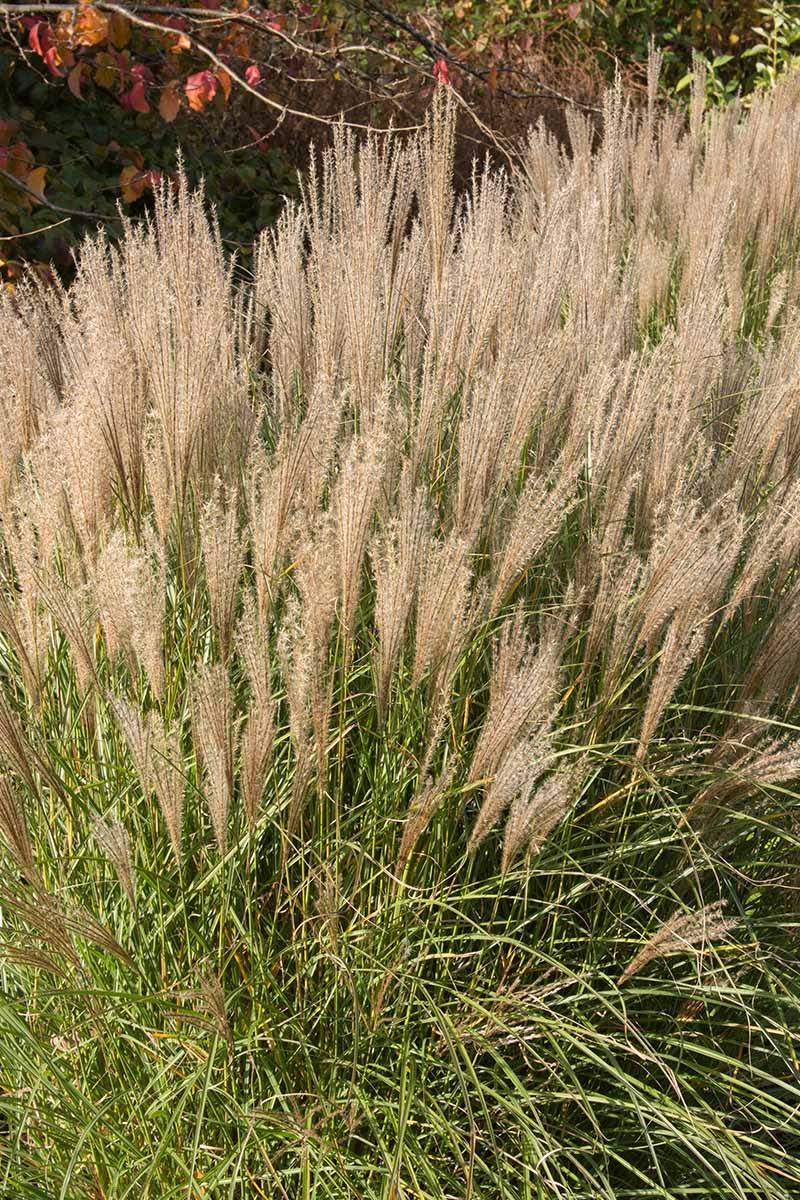
Pruning is best carried out in late winter or early spring before new growth starts. At this time, cut the entire plant back to four to six inches above the ground.
This will allow the plant to rejuvenate, stimulating fresh growth for the upcoming growing season.
If you prefer, you can leave the dried maiden grass stalks in place over winter for added texture. They add charming winter interest! But make sure to cut them back before new growth appears in spring.
You can learn more about pruning ornamental grasses in our guide.
Maiden grass is relatively low maintenance once established. It’s drought tolerant and doesn’t usually require extra watering unless conditions are exceptionally dry.
It’s also generally pest- and disease-resistant, although it’s a good idea to keep an eye out for signs of rust in wet weather, which I’ll discuss a little later on.
If a clump becomes too large or the center begins to die out, it’s time to divide the plant. This is best done every two to four years in the spring.
Maiden Grass Cultivars to Select
With a range of M. sinensis cultivars to choose from, you might be wondering where to start. Here are a few of the more common ones to look for:
Gracillimus
‘Gracillimus’ is a classic choice, suited for a wide range of climates in USDA Zones 5 to 9. With narrow leaves and a graceful, arching form, it comes alive with a light breeze.
‘Gracillimus’ flowers start out purple and turn almost white through their growth cycle.
Find this cultivar at Fast Growing Trees, available in one- and three-gallon containers.
Morning Light
This cultivar is notable for its variegated foliage, finely edged with white striping, giving light and contrast to your garden.
Recommended for Zones 5 to 9, ‘Morning Light’ tolerates a range of soil types. But like other maiden grass varieties, it prefers well-drained soil, making it a versatile option for different garden designs and situations.
Try this cultivar for shimmering visual contrast against an abundantly darker green background. In the fall you may notice the pinkish blooms turn bronze, adding seasonal color to your garden.
Find ‘Morning Light’ at most nurseries, greenhouses, and even big box garden centers. Or find it online at Planting Tree where it’s available in one-gallon containers.
Silver Feather
‘Silberfeder,’ or ‘Silver Feather,’ is known for being especially hardy, able to cope in colder regions as far north as Zone 4.
Its name describes the handsome, silvery plumes that rise above the plant in late summer, making a beautiful, fluffy display.
This cultivar could be a smart choice for gardeners in northern areas of the United States where winters can be more severe.
If you have trouble finding it locally, choose between one-quart and #3 containers at Nature Hills Nursery.
Zebrinus
This cultivar stands out in a crowd with its horizontal yellow bands, or zebra stripes, across the leaves.
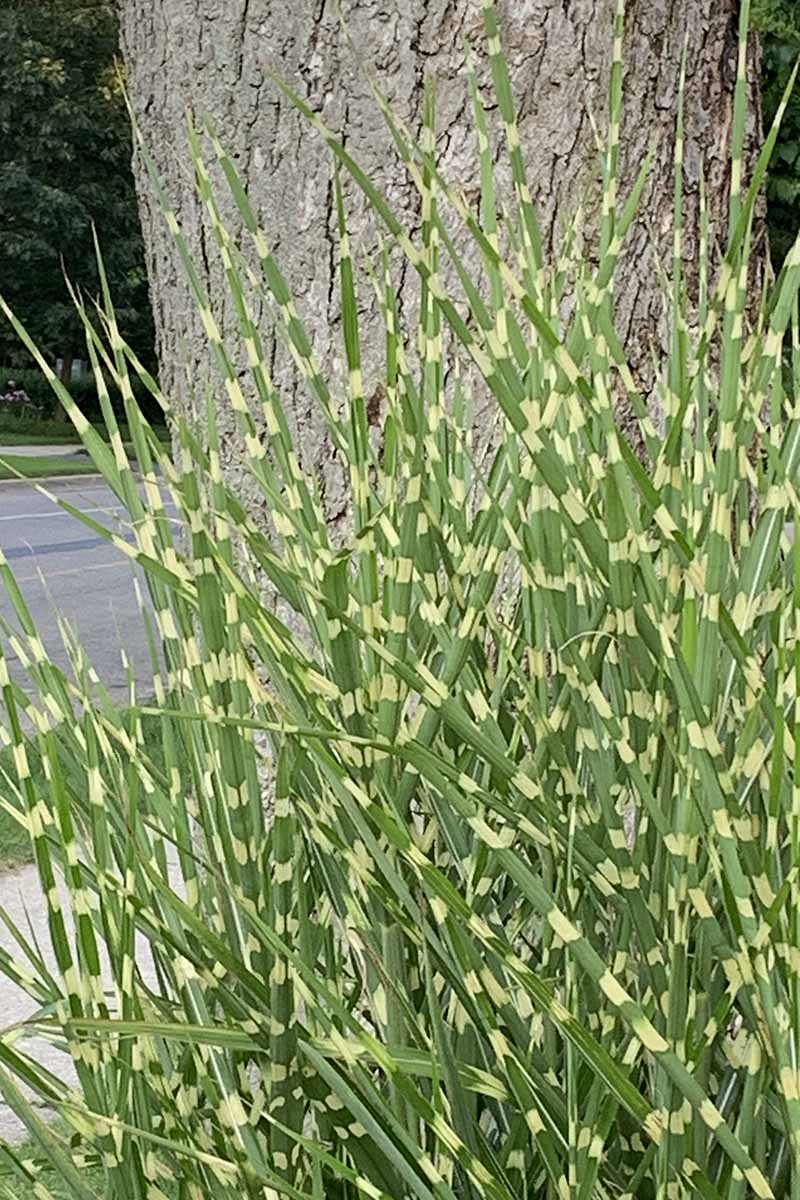
It’s suitable for USDA Zones 5 to 9 and is known for its high tolerance to a diverse range of soil conditions, including clay soils.
Zebra maiden grass could be a wonderful choice for gardeners in regions with challenging soil profiles. It can reach up to eight feet tall and six feet wide, so plant for its mature size.
If you like the look of this variety but don’t have the space, consider a dwarf cultivar instead, which maxes out at four feet tall and three feet wide.
‘Little Zebra’ is available from Nature Hills Nursery.
The plumes are darker than those of ‘Zebrinus,’ and when its burgundy flowers come into bloom, this unique combination of stripes and color provides an attractive display.
Managing Pests and Disease
M. sinensis is generally considered low maintenance, with few pest issues to be concerned with.
Most of the notorious herbivores, including the usual suspects like deer, typically avoid maiden grass due to its tall, coarse leaf structure.
They’re not very pleasant or tasty to eat! This makes Japanese silver grass a good choice for landscapes where these visitors like to hang out.
But a few pests and diseases might give you a bit of trouble from time to time, so let’s review them here just in case.
Pests
It’s important to remember that insects can carry disease, so staying on top of infestations will help you to get ahead of potential issues.
Look out for these bugs and you’ll be in good shape:
Aphids
Aphids are tiny, sap-sucking bugs that attack a wide range of plants, including maiden grass. They can cause distortion and yellowing of the leaves and impede a plant’s growth.
Try battling them with insecticidal soaps and neem oil. Or blast them with the hose to dislodge them.
Ladybugs love to feast on aphids, so consider bringing some in if you don’t see them in your garden.
Learn more about how to deal with aphids in our guide.
Mealybugs
Mealybugs are small, soft-bodied insects covered in a white, waxy substance. They can live inside the stems of M. sinensis, causing stunted growth.
These insects could be tricky to eradicate. If an infestation isn’t too severe, you can spray with an insecticidal soap or neem oil.
You can also introduce or encourage natural predators like ladybugs or lacewings. These good bugs should keep the bad ones in check.
If natural solutions aren’t enough, you can treat these bugs with a systemic insecticide applied in late spring or early summer when they’re most active.
Read our guide to managing mealybugs to learn more.
Spider Mites
These miniature arachnids will also suck the life from your plant. Signs of infestation include yellowing and browning of leaves, and fine webbing on the plant.
They love hot, dry conditions, so if you live in this type of climate, be on the lookout for spider mites.
Miticides or insecticidal soaps specifically designed to tackle spider mites are available.
Try Bonide Mite-X spray, available at Arbico Organics. It uses botanical oils to fight these pests.
If your gardens are particularly prone to these pests and you’ve had previous infestations with this plant or other plants nearby, a regular preventive misting might help.
Check out our guide to spider mites to learn more about these pests.
Disease
As I mentioned before, M. sinensis isn’t overly susceptible to disease, but there are two top contenders to watch for.
Leaf Rust
Leaf rust is a fungal disease that can become a nuisance for Japanese silver grass. To identify it, look for yellow, orange, or red blisters on the leaves.
To treat leaf rust, remove and destroy infected leaves and apply a fungicide intended specifically for ridding your plant of rust disease.
Also, make sure your plant has good air circulation to discourage fungal growth.
Miscanthus Blight
Miscanthus blight attacks the leaf blades and sheaths, or the lower portion encircling the stems.
Stagonospora species of fungi cause the spots and infection can eventually lead to death in severe cases. The pathogens thrive in damp or wet, humid conditions.
Practice good garden sanitation by removing and destroying infected leaves. If your plants have contracted blight in the past, consider applying fungicides as a preventative method.
Keep in mind that your best defense against pests and disease is to keep your plants healthy. Water when appropriate and practice good sanitation to promote good health.
Best Uses of Maiden Grass
Japanese silver grass is a versatile ornamental plant that can be incorporated into your landscape in various ways.
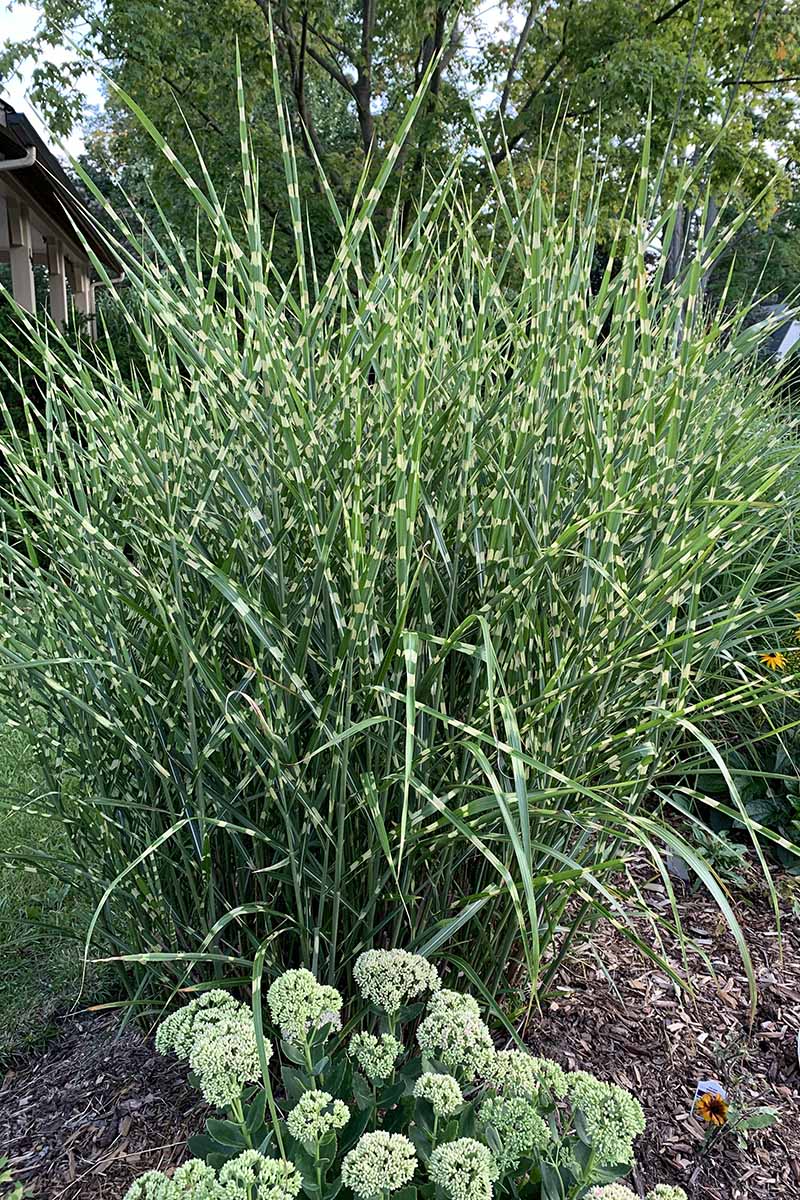
Its tall, elegant plumes make it a lovely choice for privacy screens, or a backdrop for other plantings, adding depth and structure to your garden.
Maiden grasses can also make breathtaking specimen plants, with their striking autumnal color and winter interest.
They’re perfect for mass planting and make a big impact with a sea of movement and color in larger garden spaces.
Due to their robust and hardy nature, M. sinensis and other ornamental grasses can also be grown in containers and make a good option for creating privacy in various sitting areas like patios and around pools.
Quick Reference Growing Guide
| Plant Type: | Ornamental grass | Flower / Foliage Color: | Beige, purple, red, silver/green, variegated yellow and green |
| Native to: | Eastern Asia | Tolerance: | Black walnut, deer, drought, erosion, heat, salt |
| Hardiness (USDA Zone): | 4-9 | Maintenance | Low |
| Bloom Time: | Summer/year-round interest | Soil Type: | Clay, loam, sandy |
| Exposure: | Full sun to partial shade | Soil pH: | 5.5-7.0 |
| Spacing: | 3-5 feet | Soil Drainage: | Well-draining |
| Planting Depth: | Soil surface (seeds), same depth as container (transplants) | Uses: | Backdrop, fall and winter interest, mass planting, privacy screen, specimen or focal point |
| Height: | Average 3-7 feet; some varieties up to 12 feet | Order: | Poales |
| Spread: | 3-6 feet | Family: | Poaceae |
| Water Needs: | Low | Genus: | Miscanthus |
| Common Pests and Diseases: | Aphids, mealybugs, spider mites; miscanthus blight, rust | Species: | Sinensis |
Take a Walk on the Wild Side
The playful plumes and tantalizing textures of maiden grass may have you shaking your tail feathers.
If you’ve been on the hunt for the perfect addition to your gardens, check these grasses out. They’re sure to bring that texture, movement, and depth that your landscape is lacking.

After reading this guide, you know the history of this versatile, hard-working plant, how to grow and take care of it, which cultivars to start out with, and where to find them.
If you have a fun and creative display of Japanese silver grass in your own landscape, please share your ideas and photos with us in the comments below!
For more information on the wonderful world of cultivating ornamental grasses, read these guides next:

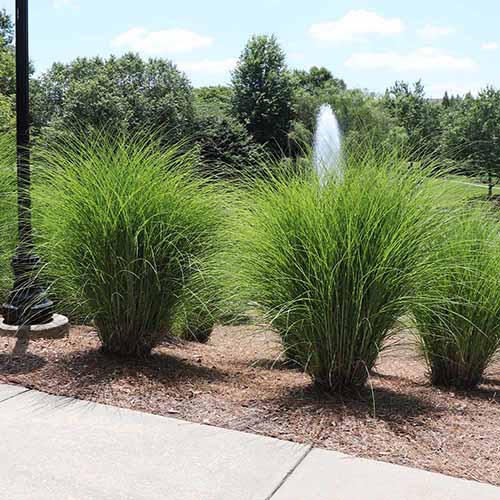
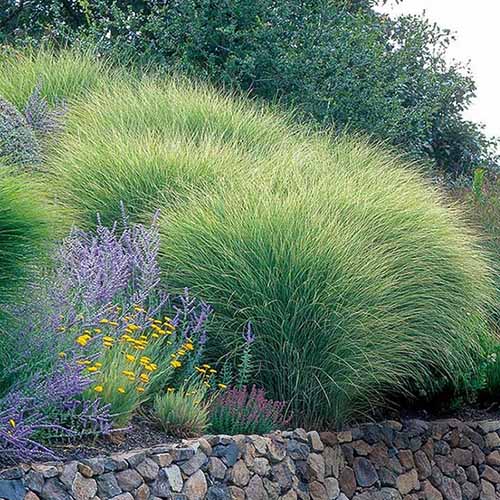
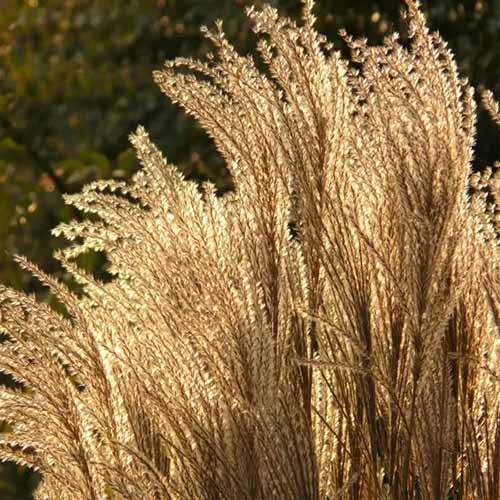
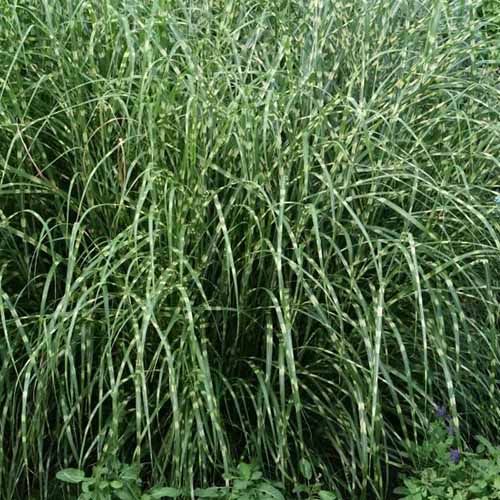
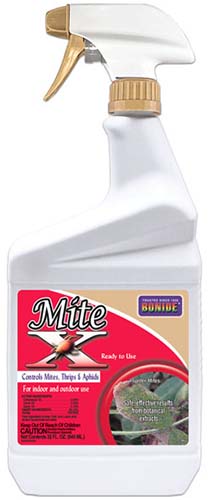
Miscanthus is invasive. Please plant a native alternate like big blue stem, little blue stem, Indian grass, or switch grass instead. This stuff is very aggravating to eradicate from natural areas, and is one more non-native threat to our flora and fauna that we could go without.
Did you actually read the article? This was covered in-depth.
Thanks for the feedback, Kegan. The matter of its potential invasiveness is addressed in the article. Our growing guides provide details about each specific plant – including areas where they may be considered invasive – and we trust that gardeners will make up their own minds as to whether or not to grow any particular species.